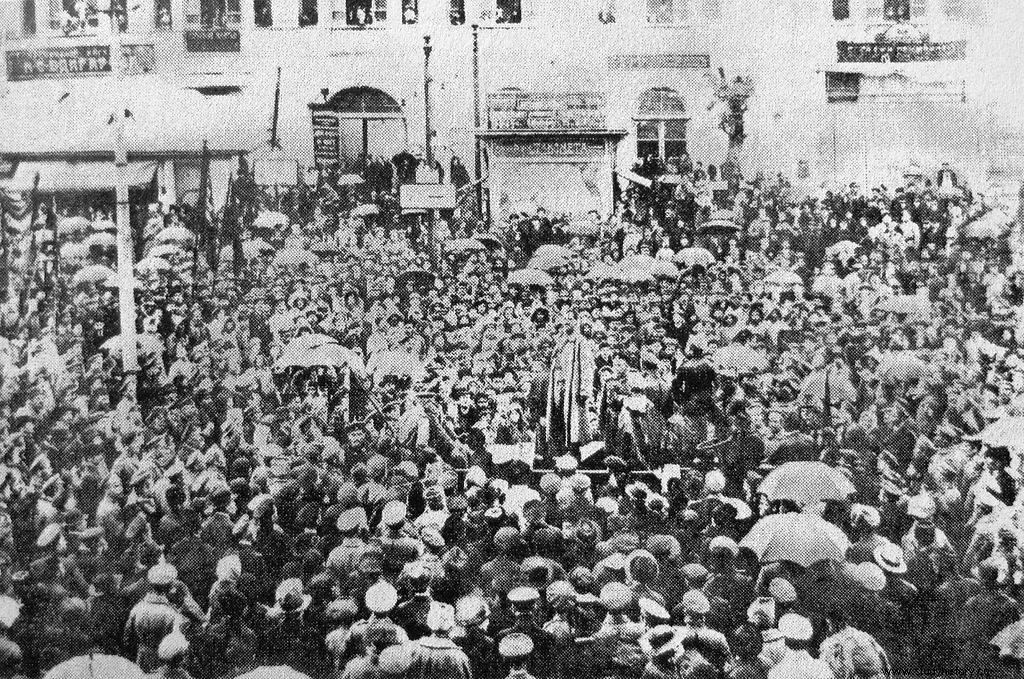- The social crisis has been in place in Russia for a long time:the country had already experienced a revolution in 1905, but Tsar Nicolas II remained in power. The context is difficult, with an 85% rural population suffering from famine, an underdeveloped country subject to the dictatorship of the bureaucracy and the army while the family of the tsar is subject to the influence of a Rasputin that the corruption is suspected.
- Since 1905, Russia has developed into a major industrial nation, but most of the capital is held by foreign companies; the bourgeoisie is developing rapidly, in clear contradiction with the growing number of workers whose life is difficult. Two Marxist parties oppose the Tsar:the Mensheviks, who seek to install a socialist state, and the Bolsheviks, who seek to establish the dictatorship of the proletariat. The First World War exacerbated tensions until the revolutions of February and October 1917. The war was cruel for Russia, which lost 900,000 men in 1915 alone. The Empire could no longer supply the army, and the economic situation is deteriorating with famine and galloping inflation.
February and October 1917

Characters
Nicholas Alexandrovitch Romanov alias Tsar Nicholas II
Vladimir Ilyich Ulyanov alias Lenin
Leon Trotsky
Joseph Stalin
Procedure
February Revolution
The winter of 1916-1917 was particularly cold and the economic situation became unsustainable. Rasputin is assassinated on December 31 while the bourgeoisie is plotting against the Tsar; the Bolshevik party organizes a general strike on January 21, 1917, but despite their scale, the demonstrations are a failure.
The Duma (parliament) is suspended by the Tsar while the Bolsheviks refuse to join the national unity movement.
In March, while food is rationed, strikes multiply throughout the Empire, hardly contained by the army. On March 12, part of it joined the demonstrations near Petrograd (Saint Petersburg), allowing 40,000 demonstrators to be armed.
The Mensheviks form the Petrograd Soviet representative of the workers, and the Bolsheviks join it. Together they elect a new government, but the Bolsheviks remain suspicious.
The Tsar abdicated on March 15 and the Soviet entered the Duma, restoring democratic freedoms.
February – October
The Mensheviks are in the majority in the Duma, and the Bolsheviks support the new government reluctantly. For them, it would have been monopolized by the bourgeoisie.
In 1917, Lenin published the "April Theses" in which he positioned himself against the government and for the continuation of the revolution towards a real dictatorship of the proletariat which would control all the institutions of the country, where all the lands and businesses would be nationalized.
The April Theses had little impact at first, but at the beginning of May 1917, the provisional government announced the continuation of the war:large popular demonstrations took place, and the population approached the Bolsheviks who demanded end of the war.
This crisis led to the establishment of a more moderate government. Faced with this, the Bolshevik party rallied to Lenin's theses and reinforced the protest, with the program:"bread, land and peace".
On July 3 and 4, as the situation hardens on the front, a large Bolshevik insurrection is hardly contained by the army in Kronchtadt. The government becomes more conservative, united against the Bolsheviks. The latter, realizing that they can no longer win power democratically, decide to organize the revolution.
On August 27, 1917, General Kornilov, conservative of the old regime, attempted a coup, repelled by the Bolsheviks. At the same time, the economy is still deteriorating, the social situation is increasingly violent, with large-scale urban and rural demonstrations.
In this climate, the Bolsheviks, which had only 200,000 members, won great popular support.
October Revolution
Between September and October 1917, Lenin, Trostsky and Stalin tried to convince the Central Committee of the Bolshevik Party to enter a revolutionary phase and not to support the Preparliament, which was supposed to constitute a new regime. Little by little, the party prepares the Revolution.
On October 9, Lenin created the Revolutionary Military Committee of Petrograd (CMR), which he chaired; on October 16, the party calls for an insurrection.
On November 4 (October 22 in the old Russian calendar), the army rallied to the CMR.
On November 6 (October 24), counter-revolutionary forces rallied around the Winter Palace in Petrograd.
On the night of November 6-7 (October 24-25), the CMR led by Lenin took control of the city while the cruiser Aurora , Bolshevik, threatens to bomb the Winter Palace.
On November 8 (October 26), Aurora bombards the palace and the soviet meets; he seizes power, dissolves the Preparliament and the Mensheviks, in the minority, are booed. The revolution caused few deaths.
Consequences
- The Council of People's Commissars, the body of power headed by Lenin, was created on November 8 (October 26). He took the end of the war as his first step and began collectivization.
- Russia enters the civil war and still has to fight against the conservative white army.
- Lenin imposed himself as a strong man of power in a veritable Party dictatorship.
- From the beginning of the October Revolution, two currents opposed each other:Trostsky's theory of Permanent Revolution and Stalin's Revolution by Stages.
